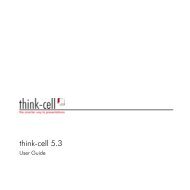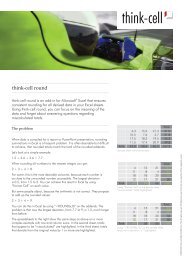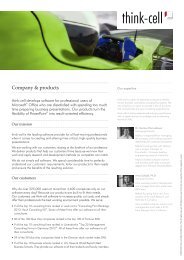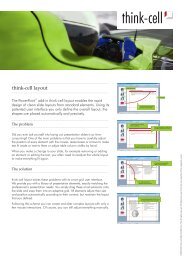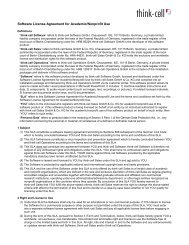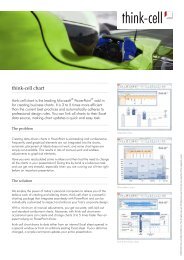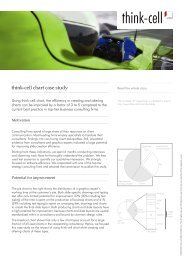think-cell technical report TC2003/01 A GUI-based Interaction ...
think-cell technical report TC2003/01 A GUI-based Interaction ...
think-cell technical report TC2003/01 A GUI-based Interaction ...
You also want an ePaper? Increase the reach of your titles
YUMPU automatically turns print PDFs into web optimized ePapers that Google loves.
2.2 Quantitative Aspects FIELD STUDY<br />
The intention of the quantitative study is to clarify which PowerPoint-related<br />
problems have the most impact on the over-all working process. At the same time,<br />
data emerging from a quantitative evaluation of current PowerPoint use provides a<br />
baseline for comparative follow-up studies. A case study that evaluates the impact<br />
of my work is presented in chapter 6.<br />
2.2.2 Methods and Data Validity<br />
While data collected on-site and during the actual process is most authentic, it<br />
takes too much time to collect enough data for a valid statistic evaluation this<br />
way. Therefore, mass data was collected by indirect methods off-site, while on-site<br />
observation was used to check the results for plausibility.<br />
Again, data was largely collected from a single consultancy office. Comparison<br />
with sample presentations from other consultancies showed that – with little devi-<br />
ation of the absolute numbers – the general layout and the use of visual elements<br />
and chart types is sufficiently similar across different consultancies to generalize the<br />
findings of the study.<br />
Live Timing. As a first approach to quantitative data, I did on-site user observa-<br />
tion and live timing of PowerPoint related activities. For each item, some specifics<br />
including the type of activity and the skill level of the performing user were recorded<br />
along with the actual time required to perform the task. Moreover, for each tuple<br />
of data the affected slides were kept to allow a comparative study later.<br />
Expert Ratings. To collect a statistically relevant amount of data in reasonable<br />
time, I decided to rely on off-site expert ratings. Together with an experienced<br />
visual, I went through 6 entire presentations that were selected as a representative<br />
sample, with a total of 371 slides. For each slide, I had the expert estimate the total<br />
time required to create the slide as well as times for text input and single elements<br />
like drawings and charts.<br />
Data collected from expert ratings was backed up with a random sample of other<br />
experts’ ratings and with live timings. The verification confirmed the estimated<br />
times to be plausible and accurate.<br />
Analysis and Counting. As another off-site method to efficiently collect larger<br />
amounts of data, I went through 9 presentations (567 slides) that were rated to be<br />
representative. I categorized graphical elements and chart types and counted the<br />
occurrences.<br />
Moreover, I put aside those slides that appeared especially difficult for computer<br />
support. The sample of difficult slides helps to validate new layout concepts and to<br />
clearly define the requirements for a better solution.<br />
Interviews. Just as for qualitative data, interviews are an appropriate method to<br />
access hard-to-measure quantitative data as well. In this case, personal interviews<br />
were the only way for me to collect data concerning the consultants’ point of view.<br />
21



